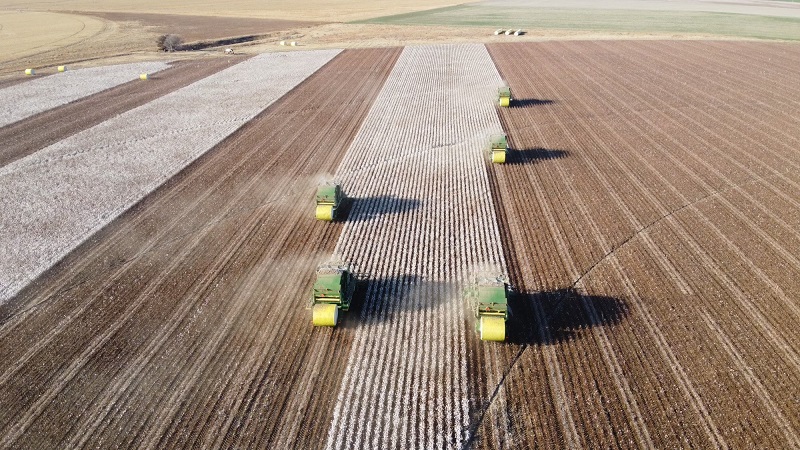It Was No Accident
In 2000, cotton yields in Texas averaged 430 pounds per acre, according to USDA, and quality was nothing to get excited about. But by 2007, yields were 400 pounds more and quality had shown a dramatic improvement. Texas now has some of the highest quality Upland cotton in the world.
That didn’t happen by accident, says Randy Smith of Ropesville, TX. Randy Smith Farms raised 3,700 acres in Hockley, Lynn, Lubbock and Terry counties in 2008. He credits varieties that are more adaptable to his area of the High Plains, traits and boll weevil eradication for the 180-degree turnaround.
“With the introduction of FiberMax varieties in West Texas, our whole industry changed,” Smith says. “We’ve gone from stripper varieties to picker varieties. Until 1999, I had never planted a picker variety.”
Smith says that at that time he was planting a conventional stripper variety. He was working with a consultant from Australia – Amos Dror – on a drip irrigation system, and Dror asked him what variety he planted. “I told him it was a stripper variety, then he basically called me stupid and said I should be planting a picker variety,” Smith says. “I didn’t appreciate it, but I did take heed. All I’d ever known was stripper varieties because of the losses we can have from bad weather. We thought we needed a tight-lock cotton, but we think the varieties from FiberMax we plant now are a little tighter.”
It didn’t take long for Smith to get over Dror’s insult and they remain friends. “I still work with him,” Smith says. “With the production increases we saw, within 2 years I was using 100% FiberMax picker varieties.”
Talking Trait
Smith’s use of FiberMax varieties was a progression as he worked his way through conventionals to traited varieties. In 2008, his most widely planted variety was FM 960B2R, followed by FM 9063B2F, FM 1880B2F and FM 9180B2F.
He has also planted one of FiberMax’s Liberty Link varieties, and says, “I have some 958LL and was extremely happy with the quality and grade.”
Weeds and insects have become much less of a problem in all areas with the introduction of the Roundup Ready, Roundup Ready Flex, Bollgard and Bollgard II traits.
“What we’re getting with Bollgard II is complete bollworm control,” Smith says.
Bollgard technology has also helped with beet armyworms. “Beet armyworms were a terrible problem in 2000,” he adds. “In fact, it almost put us out of business – we sprayed and sprayed. We didn’t have an adequate tool then.”
On the High Plains, working around heavy rains, hail storms and high winds is the rule rather than the exception. “We have to do a lot of sand fighting and when you’re doing that, spraying weeds is the last thing on your mind because it’s the least important,” says Smith.
Roundup Ready technologies didn’t completely cure weed problems, but they made them more manageable and less of a concern. “We could probably go through the season with only one spraying, but I’m not that confident.” Smith says. “I did a couple of fields (in 2007), but I didn’t do it intentionally.”
Any fan of old Westerns knows what tumble weeds are, and they can be a problem in West Texas cotton fields. “Sometimes those things can get pretty big before you can get a sprayer in the field,” says Smith.
That’s one of the reasons he says he would be reluctant to go without using one of the yellow herbicides. “I use Treflan and Prowl in February or March and incorporate them,” he explains. “We’ve used Staple and Caparol in the past at planting.”
I’m a Believer
Because of the high initial per-acre cost of boll weevil eradication programs (BWEPs), many growers in the Cotton Belt were brought into them kicking and screaming. But after BWEPs worked their way from the Carolinas and Georgia then through the Mid-South, hymns were being written about them. There are now areas in the Southeast and the Mid-South where the boll weevil is officially eradicated.
But unlike those areas, BWEPs on the High and Rolling Plains were not a given. Programs were voted in, voted out, then back in again.
“In 1999, I sprayed seven times for boll weevils on a patch of drip-irrigated cotton, but fortunately boll weevil eradication came back into existence after that,” says Smith. “We’re at a maintenance level now and I firmly believe in the program. We’re down to $3 per acre for both irrigated and dryland and that’s pretty minimal.
“They did an excellent job with the program and I’m certainly glad it was brought back. We wouldn’t be here if it had not.”









